Suggest a topic
Suggest a new Did you know? topic

Dancing in Adelaide
891 ABC Afternoon Delights at the State Library : 15 March 2005
Carole Whitelock talked with Michael Talbot
Dancing in Adelaide
Dancing was extremely popular - especially in the 1920s and 1930s. I looked at advertisements in The Advertiser on the middle Saturday in March at five year intervals from 1920. I was amazed not only at the number of venues but that many several operated most nights of the week. And there were a large number of dancing classes advertised as well.
Palais - North Terrace
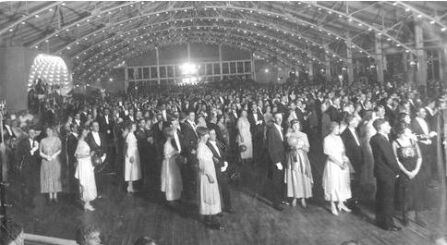
PRG 280/1/28/382 - Opening night at the Palais, 1920
The longest and most popular venue was the Palais on North Terrace. It opened as the Palais de Danse in April 1920. Most recently it was known as the Palais Royal. For a short time the venue produced a little magazine called The Palais Pepper Pot with the by-line 'Costs nothing - Worth Less. Edited (through no fault of his own) by "Yours radiantly".'
In September 1920 the weekly program was dancing on Monday, Tuesday, Friday, and Saturday nights. On Wednesday there was Twilight jazz - i.e. subdued lighting all evening and moonlight effects. Thursday was a Fancy Dress Carnival. On Saturday afternoons from 3 to 5.15 there was a The Dansant. For 5/-, or £1 on Thursdays, you could hire a box with room for 12-14 people.
The picture at the opening of the Palais shows people holding balloons. One of the events at the Thursday Fancy Dress Carnival was the Balloon chase with two prizes of ten shillings.
Music played in September 1920 included Bubbles Waltz, Oriental Memories Waltz, You'd Be Surprised Fox-Trot, Dardanella Fox-Trot, Vamp Fox-Trot, Shirley Jazz Fox-Trot, Oh! Helen One-Step, the Sandunes One-Step, Kissing Time Waltz, My Baby's Arms, I've got my Captain working for me now, Big Brass Band, Tripoli, Hawaiian Moonlight, Kismet Fox Trot, Dreamland Brings Memories of You, The Barber's Beano, Californian Nights. The music could be bought from Miss Gertie Campbell's, Bowman's Arcade, Adelaide.
The Palais was demolished in 1967. The site is now a car park.
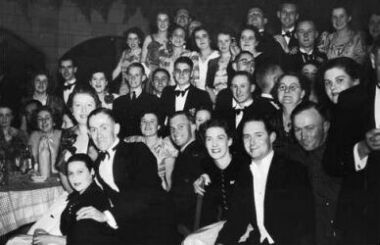
B 54668 - Party scene at the Palais Royal, 1941
The Floating Palais
I'd love to know more about the floating Palais on the Torrens Lake off Elder Park. It was erected in 1924 and demolished in 1929.
In The Advertiser for 14 March 1925 the Floating Palais de Danse was advertised as 'The Garden Palais, one of the most distinctive and beautiful places of entertainment in the Commonwealth'. 'The coolest spot in Adelaide'. It 'provides to a degree usually unobtainable in the public palais, a perfect atmosphere of intimate seclusion, joie de vivre, and romance. Open nightly. Prices 1/3. Saturday 2/- (plus tax). Garden Palais, Ltd. Bowman's Buildings, King William St. Phone C. 1948.'
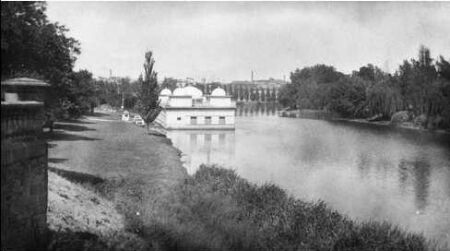
B 60338 - Floating Palais de Danse, 1929
I've seen references to it as the 'Taj Mahal of the Torrens', as having held a 'famous Fig Leaf Ball', and 'the night "Tinker" Wallace, during a frenzied number with a band, disappeared overboard into the river.' 'A local dancer, Johnny O'Loughlin is supposed to have competed in a marathon dance at the Floating Palais with a live python as his partner.' (Music! Dancing!)
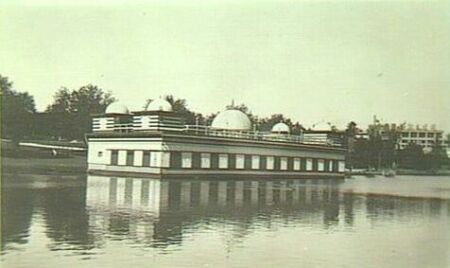
B 4109 - Floating Palais, 1927
The State Library has about a dozen exterior photographs taken from the shore, but I've not found any interior pictures, or personal accounts of dancing at the Floating Palais. If anyone has photographs - particularly interiors - the Library would be very interested.
Other venues in the city
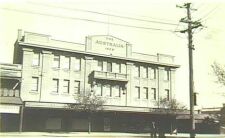 |
|
|
B 5700 - 'The Australia' dance and concert hall, 1930 |
Many halls in the city were used for dances. Australia Hall in Angus street - now the Royalty theatre - opened in 1929. The Astoria Ballroom (corner of Waymouth and Young Streets) opened in December 1941. It was built specifically as a dance hall, and had a sprung floor.
The Kings Ballroom - for a time Legacy House - was at 318 King William Street. The Mars Bar nightclub is currently one of the building occupiers of what was Osborne Hall at 122 Gouger street.
Many suburban halls provided venues. The Quadrille classes in the 1920s at the Woodville and Goodwood Institutes must have been well behind the times. The Maison de Danse in Colley Terrace, Glenelg and the Semaphore Palais were two of the largest suburban venues. The Burnside Town Hall is still used for dances. Probably the last to operate on a regular basis was the Wonderland on Belair Road.
Dances
Most dance halls ran old style and modern dancing. In the '20s the dances included the Charleston, the Big Apple, the Black Bottom and the Military Two Step. The Palais Pepper Pot in 1920 mentioned the Waltz, Fox-Trot, One-Step. Advertisements in the Advertiser in 1925 added the Tango.
'Glyde', summing up the dances for 1932 in The Advertiser (29 December 1932) wrote:
(I)n old style the following new dances were introduced: - Royalty waltz, gem waltz, Floradora, empress tango, western star waltz, waltz Palmer ... all these dances were favourably received by the public, indicating that something new is required each year. The adoption of the quickstep and slow fox-trot as the main dances of the year was the feature of modern dancing. 1930s everyone was doing the Tango, the Maxina, the Varsity Drag and Stamp, Jazz Waltz and Drag Tap.
Advertisements in March 1930 mentioned Rumba, Quickstep Waltz, Slow Fox Trot or Old Style Dances. Dance teacher Aubrey Hall and Nell Teesdale were giving demonstrations of the Rumba and Tango.
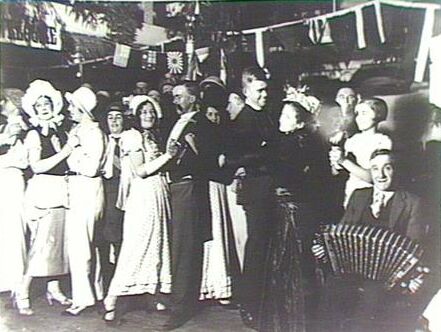
B 48292 - CWA Outback Relief Ball, 1936
People
There are few biographies of the many band leaders, dance promoters and teachers.
Aubrey Hall was the most prominent dance teacher in Adelaide, starting at 21 with classes at the St Peters Masonic Hall but quickly becoming one of Adelaide's foremost dance promoters. He taught dancing for nearly fifty years. At the 1966 Festival of Arts, he and his wife presented a festival of ballroom dancing at Elder Park. (Advertiser 7 July 1970; Music! Dancing!)
In an interview in The Advertiser (5 May 1984) Alf Holyoak remembered Harry Boake-Smith, who led the Palais Orchestra. He contrasted the image the band leader presented, with his perception of the quality of the band:
|
He was a swarthy complexioned fellow and he looked a million dollars with his tails and his white gloves and his dark complexion ... In the summer you'd see him walking down the Bay with two or three sorts on his arm and bloody good sorts they were too ... that was Smithy. The band had absolutely no idea; you had a conglomeration of musicians with no idea of phrasing; it was like dropping a box of dried peas on the floor was how it sounded ... You had a first saxophone who couldn't improvise, a tenor player as rigid as a board and a real tear-arse trombone player who used to slur every note from a couple of notes below. |
I was interested at the number of women band leaders there were in the 1920s. Advertisements on 14 March 1925 mentioned Miss Hannan's (or Hannam's) Orchestra, and a Special Orchestra under Miss Hilda Hansen. In March 1930 the bands included Melva Bartle's Orchestra, Miss Olga Durnell's Jazz Orchestra, Miss Thelma Richardson's Orchestra and Mrs Barton's Orchestra.
Hilda Hansen's Jazz Band used megaphones for singing and the band played regularly for private functions and at the Town Hall and Glenelg Town Hall. Hilda's son, Jack Barter, was also an Adelaide band leader. (Music! Dancing!)
Nightclubs
The repressive drinking laws lead to the development of nightclubs in Adelaide. Typically they opened late as dances and the pictures were finishing. I've been able to find very little about them, but there was the Plaza, the Blue Grotto, the Tuxedo and the 400 club. The State Library has a menu from the Blue Grotto signed by a number of people including Harry Boake-Smith.
Drinking at dances
In 1969 I went to my first formal ball. It was BYO (Bring Your Own alcohol), so everyone arrived carrying eskies. At something like 10pm all drinks had to be put on the floor. There seemed to be nothing to prevent you reaching under the table and helping yourself. But the drinks all had to be on the floor.
For some time you couldn't have alcohol within 300 yards of a dance hall. So you kept it in the car and made forays during the evening. In December 1933 there were complaints that after dances in the Kalangadoo Hall as many as 30 to 40 empty bottles were to be found. Also in December 1933, the Chancellor of Melbourne University said 'Drinking at dances is an abominable habit, and is done by only a few degenerates. Any Australian boy or girl who cannot have a dance without a few stimulants is not worthy of the name' (Advertiser 12,5 December 1933).
At the Palais Royal in 1920 you could get tea and coffee, aerated waters, individual cakes or a plate of assorted fancy cakes, sandwiches, or fruit salad.
Dancing to the wireless
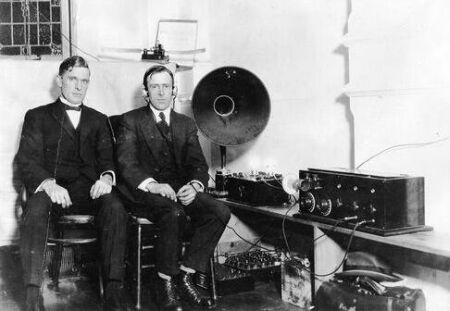
PRG 280/1/36/129 - Two wireless technicians, 1922
Alf Holyoak remembered that before World War Two the ABC broadcast music from the Palais on Saturday nights.
They had this fellow as a compere; your typical Englishman, he would elaborate on the glory of the Palais and the flowing gowns and everything. I used to say to him 'you are a bullshit Pommy you are,' and he'd say in his immaculate BBC accent 'you have to dress the place up you know, you have to dress it up' (Advertiser 5 May 1984)
At times the broadcasts would be used as entertainment at parties and dances: Social at Colonel Light Gardens. On August 20 a social evening was given by Mr and Mrs A Barber in connection with a fete to be held on 3 September. A wireless set was loaned for the occasion by Savery's Ltd, and was installed and operated by Mr AEG Donie, of Goodwood Road (Advertiser 25 August 1932).
The photograph above by D Darian Smith shows two wireless technicians sitting beside a Marconi wireless receiver providing the music for a dance held in Adelaide.
More Afternoon Delights
ABC Afternoon Delights at the State Library was a series in which Carole Whitelock talked with Michael Talbot from the State Library about South Australian topics, illustrated by items from the Library's collections. View the associated SA Memory page for each topic.


